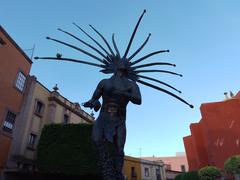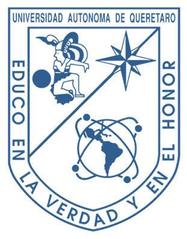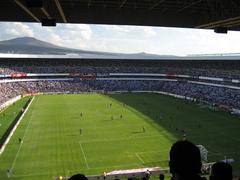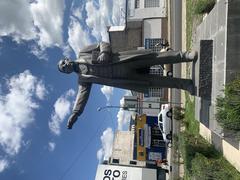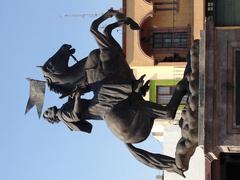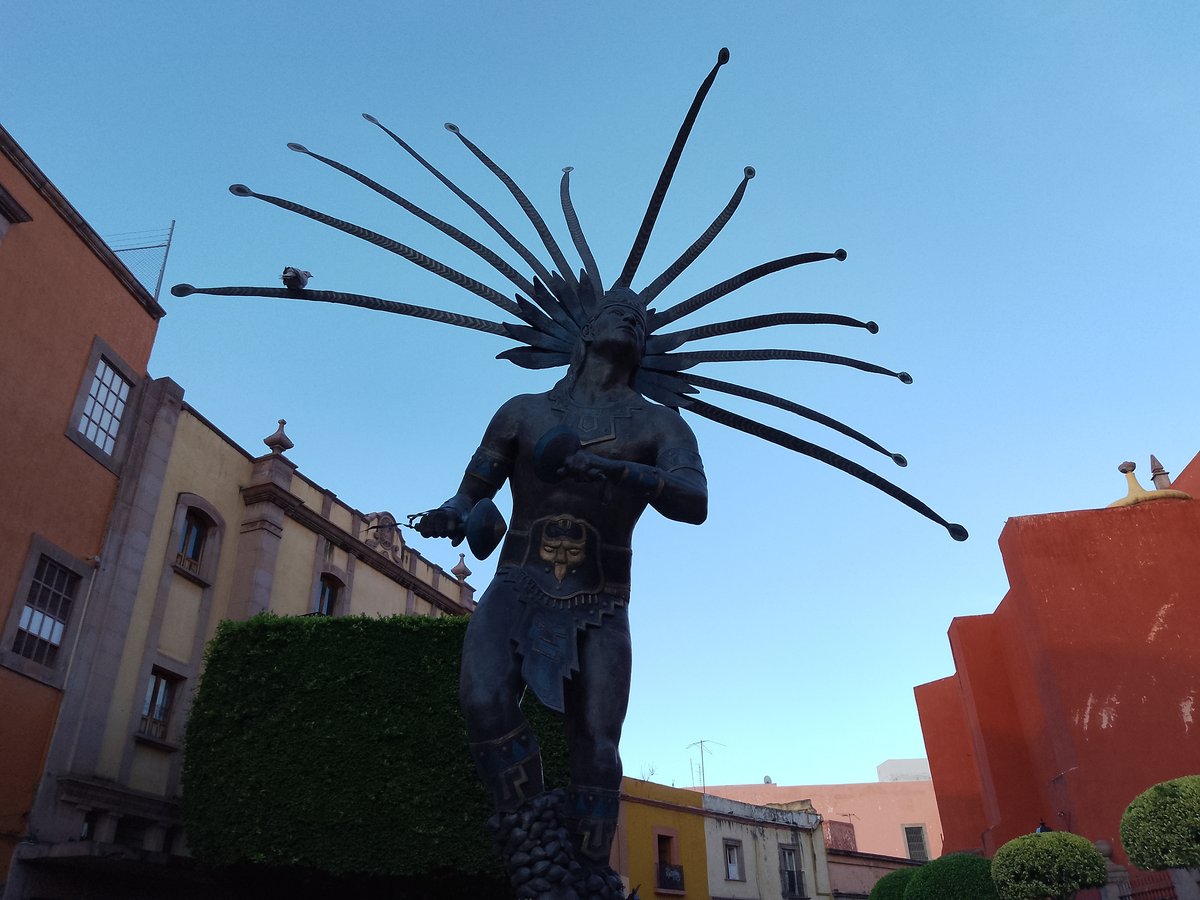
Monumento A Los Concheros, Santiago de Querétaro, Mexico: Visiting Hours, Tickets, and Travel Guide
Date: 14/06/2025
Introduction
The Monumento A Los Concheros in Santiago de Querétaro stands as a powerful emblem of Mexico’s indigenous heritage and the enduring tradition of the Danza de los Concheros. Deeply rooted in the region’s pre-Hispanic history and transformed through centuries of cultural syncretism, this site offers visitors an immersive experience into the spiritual and artistic heart of Querétaro. This comprehensive guide provides detailed insights into the monument’s origins, cultural significance, artistic features, visiting hours, accessibility, and travel tips, ensuring an enriching visit for cultural explorers, history enthusiasts, and travelers alike.
Table of Contents
- Introduction
- Historical and Cultural Significance
- Rituals, Attire, and Symbolism
- Monument Description and Location
- Visiting the Monument: Practical Information
- Special Events and Festivals
- Frequently Asked Questions (FAQs)
- Sustainability and Responsible Tourism
- Summary and Recommendations
- References
Historical and Cultural Significance
Pre-Hispanic Roots and the Chichimeca Connection
The origins of the Concheros dance and the monument that honors it are deeply embedded in the indigenous cultures of central and northern Mexico. Contrary to popular belief, the tradition stems not from the Aztecs but from the Chichimeca, Otomí, Jonaz, and Caxcan peoples—groups recognized for their resilience against Mexica rule. The Chichimeca, in particular, shaped the ritualistic and cosmological aspects of the dance, which was anchored in lunar and stellar cycles, ancestor veneration, and sacred geography (Ediciones GA).
Querétaro, especially the Cerro de Sangremal and surrounding sites, is acknowledged as the birthplace of the Danza Conchera. These locations served as ritual centers for elaborate ceremonies, marking the eight directions for ancestor worship and annual renewal.
Colonial Transformation and Syncretism
With the Spanish conquest, indigenous rituals were suppressed but not extinguished. Instead, the dances adapted—blending pre-Hispanic cosmology with Catholic iconography. The Concheros tradition became a vibrant example of syncretism, incorporating references to saints, the Virgin of Guadalupe, and Christian symbolism. The “concha” (armadillo-shell lute) emerged as a signature instrument, symbolizing the fusion of Spanish music with indigenous ritual (Bill Dahl).
Evolution of the Tradition
The tradition continued to evolve through the 19th and 20th centuries. Post-independence, Concheros dance groups spread to Mexico City and beyond, with Querétaro remaining a vital center. Today, the dance serves both as a spiritual ceremony and a celebration of folk identity. Annual events, particularly the Fiesta de los Concheros in September, draw hundreds of dancers and spectators to the city (The Queretaro Post).
Rituals, Attire, and Symbolism
Conchero dances form intricate, circular patterns symbolizing unity and life’s cycles. Ceremonies are structured around duality—nocturnal (feminine, jaguar, earth) and diurnal (masculine, eagle, sun)—mirroring both indigenous and Catholic worldviews (Bill Dahl).
Dancers wear elaborate feathered headdresses, embroidered garments, and adornments such as shells and bells. The concha lute, drums, and rattles provide rhythmic accompaniment. Rituals center on the axis mundi marked by incense burners and offerings, with movements designed to invoke earth, sky, and ancestral spirits.
Monument Description and Location
Artistic Features and Symbolism
The Monumento A Los Concheros is a striking bronze sculpture depicting a conchero dancer in full ceremonial regalia, mid-step, with a grand feathered headdress and richly decorated attire. The monument’s detailed craftsmanship honors both indigenous and Catholic influences, often featuring symbolic instruments like the concha or ceremonial staff (elmunicipalqro.com, redinfo7.com). Inscriptions or reliefs at the base recount the legendary 1531 vision on Cerro de Sangremal, which united indigenous and Spanish communities in peace (flickr.com).
The statue stands approximately 2.5 to 3 meters tall and is set in a landscaped plaza with benches and night illumination, inviting reflection and photography (minube.com.mx).
Exact Location and Accessibility
The monument is located near Jardín Zenea, at the heart of Querétaro’s UNESCO-listed historic center. Coordinates: 20.5888° N, -100.3899° W (mapcarta.com). It is accessible on foot from central hotels and attractions, with public parking and transportation options nearby.
Nearby Attractions
Notable sites within walking distance include:
- Casa de la Corregidora: Home of independence heroine Josefa Ortiz de Domínguez (programadestinosmexico.com).
- Museo de los Conspiradores: Focused on independence history.
- Templo y Convento de la Cruz: Spiritual center of the Concheros (eloficiodehistoriar.com.mx).
- Jardín Zenea: Central plaza with live music and events.
Visiting the Monument: Practical Information
Visiting Hours
The monument is in a public plaza and accessible 24 hours a day, year-round. The best experience is during daylight or early evening when it is illuminated.
Tickets and Entry
Admission is free. No tickets are required to visit the monument or surrounding plaza.
Accessibility
- Wheelchair-accessible paths and ramps are available.
- Some surrounding areas have uneven terrain; comfortable footwear is advised.
- Public restrooms and shaded seating are nearby.
Facilities and Amenities
- Numerous restaurants, cafes, and shops are within a 2–5 minute walk.
- Public transportation, taxis, and parking are easily accessible.
Best Times to Visit
- The Fiesta de la Santa Cruz in mid-September is the most vibrant period, with processions and Concheros performances.
- Early mornings and late afternoons offer the best light for photography and a quieter atmosphere.
Safety and Etiquette
- The historic center is safe and well-patrolled.
- During festivals, be mindful of personal belongings.
- Respect the monument and ceremonies—do not climb or litter, and observe rituals quietly.
Special Events and Festivals
The highlight is the Fiesta de los Concheros (September 12–15), when hundreds of dancers in full regalia perform sacred rituals and processions. The area fills with music, incense, and colorful costumes, offering an unforgettable cultural spectacle (Bill Dahl).
Other notable events include the Feast of the Holy Cross in May and Day of the Dead festivities in November.
Frequently Asked Questions (FAQs)
Q: What are the Monumento A Los Concheros visiting hours?
A: The monument is accessible 24/7 as it is in a public plaza.
Q: Is there an entrance fee or ticket required?
A: No, admission is free. Special events or guided tours may have separate fees.
Q: Are guided tours available?
A: Yes, local tourism offices and guides offer walking tours that include the monument.
Q: Is the monument accessible for visitors with limited mobility?
A: Yes, the plaza is wheelchair accessible, but some areas may have uneven paths.
Q: Can I take photographs at the monument?
A: Photography is encouraged, but always be considerate during ceremonies and ask permission for close-ups.
Sustainability and Responsible Tourism
- Support local artisans by purchasing crafts.
- Dispose of waste responsibly and help preserve the area.
- Engage respectfully with traditions—observe rituals quietly and follow local customs.
- Use local guides for deeper insights and to support the community.
Summary and Recommendations
The Monumento A Los Concheros is more than a sculpture—it is a living symbol of Querétaro’s mestizo heritage and the resilience of indigenous culture. Visit during the Fiesta de los Concheros for a full cultural immersion, or explore year-round to appreciate the monument’s artistic and spiritual significance. Complement your visit with nearby historical sites and guided tours for a richer understanding of Querétaro’s layered history.
Stay up to date on events and tours via the Official Querétaro Tourism Website, the National Institute of Anthropology and History (INAH), and by downloading the Audiala app for curated content and travel tips.
References
- Official Querétaro Tourism Website
- National Institute of Anthropology and History (INAH)
- Fiesta de los Concheros in Querétaro, Mexico – Bill Dahl
- Tradición Conchera de los Danzantes – Ediciones GA
- Fiesta de los Concheros in Querétaro – The Queretaro Post
- Concheros de Querétaro – El Municipal Querétaro
- Los Concheros de Querétaro – Red Info 7
- Monumento a los Concheros – Minube
- Traditional Indigenous Dancers – Mexico City Perambulations Blog
- Danza de los Concheros Significance – El Universal Querétaro
- Mapcarta – Monumento A Los Concheros Location
- Zona de Monumentos Históricos de Querétaro – Programa Destinos México
- El Oficio de Historiar – Templo y Convento de la Cruz
Image suggestions: Photos of the monument during a dance performance, close-ups of traditional costumes, panoramic views of Cerro de Sangremal, and nearby Plaza de Armas.
Alt tags: “Monumento A Los Concheros visiting hours and dance performance”, “Traditional Concheros dancers in Santiago de Querétaro”, “Cerro de Sangremal historic hill near Monumento A Los Concheros”, “Plaza de Armas colonial square in Santiago de Querétaro”.
